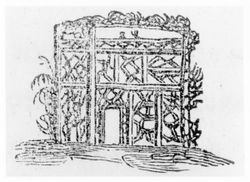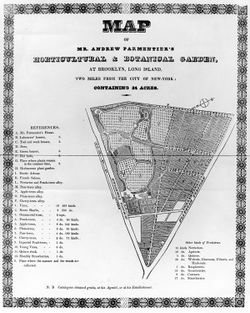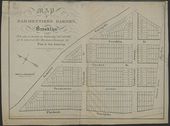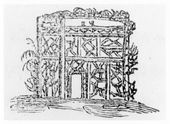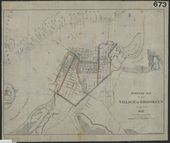Parmentier’s Horticultural and Botanical Garden
Overview
Alternate Names: Parmentier’s Horticultural and Botanic Garden; Horticultural Botanic Garden; Horticultural Garden; Parmentier’s Garden
Site Dates: 1825–1833
Site Owner(s): André Joseph Ghislain Parmentier 1780–1830; Sylvie Parmentier 1793–1882;
Associated People: Grant Thorburn 1773–1863; George Fuller; Owen Redden; Dr. Adrian Vanderveer 1796–1857;
Location: Brooklyn, NY, on the site of what is now the Brooklyn Academy of Music · 40° 41' 11.36" N, 73° 58' 47.42" W
Condition: Demolished
Keywords: Arbor; Avenue; Botanic garden; Bridge; Chinese manner; Dutch style; Fence; Greenhouse; Hedge; Hermitage; Hothouse; Landscape gardening; Modern style/Natural style; Nursery; Orchard; Pavilion; Picturesque; Pot; Rustic style; Shrubbery; Temple; View/Vista; Walk; Wall
Parmentier’s Horticultural and Botanical Garden was a nursery founded in 1825 by the Belgian-born horticulturist, André Parmentier, who immigrated with his family to Brooklyn in May 1824. Clearly, Parmentier had designs of creating a nursery in the United States even before departing Belgium: in the notice of his election to the New-York Horticultural Society in June 1824, he is described as having brought with him “an extensive collection of fruit trees, rare plants, and seeds.”[1] He was recognized almost immediately in the horticultural press for introducing several rose species into this country.[2]
History
One of the earliest advertisements for the nursery, published in the New-York Evening Post on June 6, 1825, describes the location of the garden at the intersection of Jamaica and Flatbush turnpikes—which, at the time, was just outside the village of Brooklyn.[3] The site, according to one period commentator, was originally “one of the most stony, rugged, sterile pieces of ground on the whole island,” but was transformed by Parmentier’s industry into a richly stocked nursery, laid out according to the principles of “picturesque gardening.”[4] It featured winding, sinuous walking paths and, most notably, a rustic belvedere (and was occasionally referred to as an arbor) [Fig. 1] that allowed for “a view of the whole garden and the surrounding scenery . . . including Staten Island, the Bay, Governor’s Island, and the city of New York.”[5] Although the primary business of the nursery was to sell plants—with a focus on grape vines, fruit trees, and roses—it also served a dual purpose as a place for public enjoyment.[6] Indeed, many of Parmentier’s sales were made through the post or through agents, such as the seedsman Grant Thorburn, and the Horticultural and Botanical Garden functioned more as promotional tool, drawing visitors and modeling how they might lay out the plants acquired there.[7] To that end, Parmentier also offered his services as a landscape designer, and was identified by A. J. Downing as “the only practitioner . . . of any note” in the United States. Downing described his nursery as having offered “a specimen of the natural style of laying out grounds, . . . and contributed not a little to the dissemination of a taste for the natural mode of landscape gardening.”[8]
In about 1828 Parmentier published a broadside of his Horticultural and Botanical Garden featuring a map of the grounds, offering a most detailed view of the layout and design of his nursery [Fig. 2]. The vineyards and rose shrubs were enclosed by meandering walks that led to the “Rustic Arbour” and “French Saloon” at the east corner of the plot (situated at the upper left on the map), and straight alleys, lined with fruit trees, divided his orchards. Along the eastern edge of the nursery, abutting the Jamaica Turnpike, was a small cluster of buildings that included the barn, greenhouses, tool and work houses, as well as the Parmentier family’s home and living quarters for laborers; adjacent to these buildings were hot beds and an herbaceous plant garden.[9]The broadside is likely the document Parmentier sent to the Société d’Horticulture de Paris in 1829, and it was later reprinted, with some alterations, in the February 1832 issue of Gardener’s Magazine, and Register of Rural and Domestic Improvement.[10]
The article that accompanied the 1832 publication of the map was intended to aid in the sale of the Horticultural and Botanical Garden. Parmentier had died in November 1830 after a prolonged illness, and his widow, Sylvie, endeavored to maintain the property following his death under increasingly difficult circumstances. In March 1831 parts of the property, including a barn and outhouses, were destroyed by arson, and in September of that year the Parmentiers’ son Léon died at the age 12.[11] Sylvie Parmentier subsequently put the nursery up for sale in November 1831. Finding no immediate buyers, she continued to oversee the garden until November 1833, when she sold it to Dr. Adrian Vanderveer of nearby Flatbush. Vanderveer paid $53,000 for the garden, which he divided into lots and sold them at auction for nearly $70,000.[12]
—Elizabeth Athens
Texts
- Anonymous, June 6, 1825, advertisement for Parmentier’s Horticultural and Botanical Garden (New-York Evening Post)[13]
- “ANDREW PARMENTIER has established himself in America with a view to Horticulture, and has already set on foot a nursery of considerable extent and variety, of ornamental & fruit-bearing trees, at the cross-roads formed by the intersection of the Jamaica & Flatbush turnpikes. . . He has also a fine collection of shrubs and flowers, in pots, for sale.
- “Mr. P. intends to devote particular care to adding to his collection, those European fruits and remarkable rare trees, which are as yet unknown here, or have not been generally introduced into the United States.
- “Mr. Parmentier will be happy to exhibit his garden and nursery to the ladies and gentlemen of New York, who may honor him with a visit.”
- Anonymous, March 4, 1826, “On Landscape and Picturesque Gardens” (New-York Evening Post)[14]
- “Mr. ANDREW PARMENTIER, lately from Europe, where these gardens are generally adopted, has made at his place, at the division of the Jamaica and Flatbush turnpike, at Brooklyn, L. I. a garden of this kind, which will be the more interesting on account of the great variety of foreign trees and plants he has there introduced. —It is but half an hour’s walk from New York.
- “Mr. P. by the advice of several of his friends, will furnish plans of landscape and picturesque gardens; he will communicate to gentlemen who wish to see him, one collection of his drawings of cottages, rustic bridges; Dutch, Chinese, Turkish, French pavilions, temples, hermitages, rotundas, &c. For further particulars inquire personally or by letter, addressed to him, post paid, which will be attended to.”
- A Horticulturist [pseud.], August 1, 1826, “To the Editor of the N. Y. Advertiser” (Commercial Advertiser)[15]
- “Sir—I went yesterday to see the Garden owned by Mr. Andrew Parmentier. . . The improvements he has made in that establishment, during the short time he has been there, are really astonishing; among which may be seen peach trees planted in April, 1825, which were inoculated in the same year, and are at present between three and four feet high, having been planted but 15 months. His flower plants, which are kept covered during the heat of the day by a simple and easy method, are by that means kept a long time in blossom, and form a charming and delightful view. There are always a great number in blossom, his collection amounting to above 5000 in pots. He has besides planted 20,000 grape vines, which will occupy at least five acres of ground, and are likely, in a very few years, to furnish the market of the city of New-York with an abundant supply of that excellent and wholesome fruit. Mr. Parmentier has arranged his garden in the picturesque style, with a rustic Belvidere placed at the corner of Jamaica road, which displays a most extensive perspective. It is the first of the kind erected in the United States, and will be covered with grape vines next fall. Mr. Parmentier was very polite and attentive to me, in showing me all the details of his large establishment, which contains 24 acres of land, and is surrounded with a solid stone fence.
- “This Botanic Garden can be visited free of expense; and, as it is likely to become the most important one of the kind in the United States, strangers of taste visiting New-York, will find it to their gratification to view this garden, which is only two miles from New-York.”
- Anonymous, May 19, 1827, “Mr. Parmentier’s Garden” (New-York Evening Post)[16]
- “At the green houses in Mr. Parmentier’s Horticultural Garden in Brooklyn. . . the admirers of flowers may see many rare and elegant varieties of roses, together with many other curious and beautiful flowers now in blossom. . . Mr. Parmentier has introduced into this country the species of rose with red petals emitting the perfume of tea, sometimes called the red tea rose of Florence; this is also in flower. The Napoleon rose, and the Maria Louisa rose, with a number of others, will also be in bloom in a few days. As these plants are cultivated in pots, their transportation may be safely effected at any season.”
- Anonymous, January 4, 1828, “Rural Scenery” (New England Farmer 6: 187)[17]
- “Landscape and Picturesque Gardens.—Among the embellishments which attend the increase of wealth, the cultivation of the sciences, and the refinement of taste, none diversify and heighten the beauty of rural scenery, more than picturesque and landscape gardens. . .
- “For the introduction into this country of the design and execution of landscape and picturesque gardening, the public is much indebted to Mr. A. Parmentier, proprietor of the Horticultural Botanic Garden, Brooklyn, two miles from this city. His own garden, for which he made so advantageous a choice, may give us some idea of his taste. The borders are composed of every variety of trees and shrubs that are found in his nurseries. The walks are sinuous, adapted to the irregularity of the ground, and affording to visitors a continual change of scenery, which is not enjoyed in gardens laid out in even surfaces, and in right lines. His dwelling and French saloon are in accordance with the surrounding rural aspect. In his gardens are 25,000 vines planted and arranged in the manner of the vineyards of France.”
- Viator [pseud.], August 15, 1828, “Nurseries and Gardens on Long Island” (New England Farmer 7: 25)[18]
- “At Brooklyn we called at the celebrated Horticultural Garden of Mr. ANDRE PARMENTIER. This is a recent establishment begun in 1825. It contains 20 acres, and is surrounded by a wall of masonry, after the manner which we are told is practised on the old continent. . . This garden, so far as completed, has been laid out by the very intelligent proprietor in the most modern style and with great taste; for in the branch of ornamental and picturesque gardening, Mr. Parmentier, it is believed, greatly excels.”
- Anonymous, October 3, 1828, “Parmentier’s Horticultural Garden, Near Brooklyn” (New England Farmer 7: 85)[19]
- “To the left of the garden an avenue leads to a Rustic Arbor curiously constructed of the crooked limbs of trees, in their rough state, covered with bark and moss; from the top of this arbor a view of the whole garden, and the surrounding scenery is exhibited, extending to Staten Island, the bay, Governor’s Island, and the city; at some distance from the rustic arbor is the French saloon, a beautiful oval, skirted with privet. . .
- “The green-house department, although not so extensive as some in our vicinity, contains many beautiful plants exhibited with the same tasteful arrangement which characterizes the whole of Mr. Parmentier’s establishment; even the method in disposing the pots according to some principle of grouping or contrasting the color and size of the flowers, entertains the eye, and shows the variety of ways in which a skillful gardener may distribute his materials to produce picturesque effect.”
- Anonymous, March 17, 1831, describing an act of arson at Parmentier’s Horticultural and Botanic Garden (New-York American)[20]
- “We regret to be obliged to state, that the barn and outhouses attached to Madame Parmentier’s garden, near Brooklyn, were destroyed last night by fire, together with carts, garden tools and a horse. . . [W]e are authorized by one of Mrs. Parmentier’s neighbors to offer a reward of one hundred dollars for the apprehension and conviction of the incendiary.”
- Anonymous, November 26, 1831, advertisement for the sale of Parmentier’s Horticultural and Botanical Garden (Commercial Advertiser)[21]
- “The Horticultural Garden of the Late Andrew Parmentier, Is Offered For Sale. The reputation of this establishment is not confined to the vicinity of New-York, but is well known throughout the United States, and different parts of Europe. It is situated two miles from the city of New-York, at Brooklyn, Long Island, at the junction of the Jamaica and Flatbush Roads, and contains 24 acres.
- “The Grounds are in a very high state of cultivation, and laid out with judgment and taste. The situation is very healthy, and the view very extensive, commanding the Bay, the city, &c. The garden is enclosed by a pointed stone fence, and inside of that is a hawthorn hedge. The Nursery contains a fine and extensive collection of Fruit, Forest and Ornamental Trees; also, a splendid collection of Roses and Herbaceous Plants,—the object of its late Proprietor having always been to collect every new variety.
- “On the premises are a Dwelling House, two Laborers’ Houses, seven Cisterns, and a never-failing Pump of excellent Water—four Green and Hot Houses, containing a rich variety of rare exotics.
- “The advantages to be derived by any person who wishes to engage in the occupation of Gardening, by the purchase of this property, are very great: the business already secured is very extensive, and the prospect of increased encouragement is such as to warrant the belief that the purchase of the property will amply repay the enterprise of any one who may engage in the business.
- “Terms will be made known by applying to Mrs. Parmentier, on the premises.”
- S., J. W., February 1832, “Parmentier’s Garden, Near Brooklyn,” (Gardener’s Magazine 8: 70–72)[22]
- “I have compiled from different authorities. . . an account of one of the first botanic gardens which has ever been established in this country, viz. that of Parmentier about two miles from Brooklyn, Long Island. The following map. . . will serve to convey some idea of the general disposition of the whole; but I am confident that neither plan nor description can furnish any adequate idea of the particular beauties of the place. Its establishment may, indeed, be looked upon as an epoch in the history of American horticulture; as, though the various branches of that science were before understood and practised by most of our gardeners, it had not attained its full perfection until the arrival of M. Parmentier. . . [T]he garden of M. Parmentier is, perhaps, the most striking instance we have of all the different departments of gardening being combined extensively and with scientific skill. The rapidity with which this garden was formed added to its effect. Nearly twenty-five acres of ground were originally enclosed; and the inhabitants of the vicinity beheld, with astonishment, in the short space of three years, one of the most stony, rugged, sterile pieces of ground on the whole island, which seemed to bid defiance to the labours of man, stored with the most luxuriant fruit, and blooming with the most beautiful flowers. . .
- “In the northern parts of the garden are nurseries, containing young plants of every kind of tree which is to be found in the beds. To the left of the garden, an avenue leads to a rustic arbour, in the grotesque style, constructed of the crooked limbs of trees in their rough state, covered with bark and moss: from the top of this arbour, a view of the whole garden and the surrounding scenery is obtained; including Staten Island, the Bay, Governor’s Island, and the city of New York. . .
- “In short, this establishment is well worthy of notice as one of the few examples in the neighbourhood of New York, of the art of laying out a garden so as to combine the principles of landscape-gardening with the conveniences of the nursery or orchard.”
- Anonymous, June 20, 1833, “Mrs. Parmentier’s Garden” (New-York Spectator)[23]
- “Those ladies and gentlemen who have not entirely yielded themselves to languor and repose during the brightest hours of the morning, would find themselves richly repaid by a visit to the “garden of roses” (as we must be permitted to call it) of Mrs. Parmentier. . . A lady’s taste is visible in the neatness and floral embellishments of Mrs. Parmentier’s Garden, and though there is a large domain to superintend, and though a vast variety of trees and Shrubbery for the ornament and for use, call for attention in the liberal department of the nursery, yet nothing is neglected—all is equally subject to the most assiduous care and preserving industry.”
- Anonymous, October 23, 1833, “Parmentier’s Garden” (New-York Evening Post)[24]
- “We learn that Mrs. Parmentier has recently disposed of, at private sale, the ground now occupied by her as a Garden, for the sum of fifty-three thousand dollars. . . . The rage for speculation in Brooklyn, has enabled Mrs. Parmentier to retire from active life, with a competency for herself and interesting daughters—the just reward of virtuous and well-spent lives.”
- Downing, Andrew Jackson, 1849, A Treatise on the Theory and Practice of Landscape Gardening, 4th ed. (1849: 459–60)[25]
- “Those of our readers who may have visited the delightful garden and grounds of M. Parmentier, near Brooklyn, some half a dozen years since. . . will readily remember the rustic prospect-arbor or tower, Fig. 87, which was situated at the extremity of his place. . . from its summit, though the garden walks afforded no prospect, a beautiful reach of neighborhood for many miles was enjoyed.”
Images
Anonymous, “Rustic prospect-arbor,” in A. J. Downing, A Treatise on the Theory and Practice of Landscape Gardening, 4th ed. (1849), 460, fig. 87.
Other Resources
Notes
- ↑ “Horticultural Memoranda,” New-York American (June 28, 1824), p. 2, view on Zotero.
- ↑ “Mr. Parmentier’s Garden,” New-York Evening Post (May 19, 1827), p. 2, view on Zotero.
- ↑ Advertisement, New-York Evening Post (June 6, 1825), p. 3, view on Zotero.
- ↑ “Rural Scenery,” New England Farmer 6, no. 24 (January 4, 1828): 187, view on Zotero.
- ↑ J. W. S., “Foreign Notices: —North America,” Gardener’s Magazine, and Register of Rural and Domestic Improvement 8, no. 36 (February 1832): 70–77, view on Zotero.
- ↑ Advertisement, New-York Evening Post (June 6, 1825), p. 3, view on Zotero.
- ↑ Grant Thorburn, a Scottish-born seedsman and author, is identified as an agent in numerous advertisements for Parmentier’s Horticultural and Botanical Garden. Other agents mentioned in various advertisements include the grocers Charles Swan, Harvey Spencer, and John J. Moore.
- ↑ A. J. Downing, A Treatise on the Theory and Practice of Landscape Gardening (New York & London: Wiley and Putnam; Boston: C. C. Little & Co., 1841), 21–22, view on Zotero.
- ↑ The close quarters may have led to a dispute in July 1830, when one of his laborers beat another with a garden hoe. Newspaper reports are mute on what precipitated the attack but noted that the victim, George Fuller, died shortly thereafter. His attacker, Owen Redden, was tried for murder but eventually acquitted by reason of insanity. See “Outrage,” New-York Morning Herald (July 9, 1830), p. 2, view on Zotero, and “Oyer and Terminer,” American (June 17, 1831), p. 2, view on Zotero.
- ↑ The editor of the Annales de la Société d’Horticulture de Paris noted that Parmentier sent a map of his nursery, along with a letter on the propagation of fruit trees in America; see “Sur les Arbres fruitiers d’Amérique,” Annales de la Société d’Horticulture de Paris 4 (1829): 352, view on Zotero. For the 1832 reprint of the map, see Gardener's Magazine (February 1832): 71, view on Zotero.
- ↑ For information on the fire at Parmentier’s Horticultural and Botanical Garden, see American (March 17, 1831), p. 2, view on Zotero, and for the death notice of Léon Ghislain Leopold Parmentier, see American (September 20, 1831), p. 2, view on Zotero.
- ↑ Some papers cite the original sale price as $57,000; see “Price of Farms,” New-York American (November 22, 1833), p. 4, view on Zotero. For additional details of the sale and subsequent auction, see “Parmentier’s Garden,” New-York Evening Post (October 23, 1833), p. 2, view on Zotero, “All in the Wrong,” Commercial Advertiser (November 9, 1833), p. 3, view on Zotero, and New-York American (November 19, 1833), p. 4, view on Zotero.
- ↑ Advertisement, New-York Evening Post (June 6, 1825), p. 3, view on Zotero.
- ↑ “On Landscape and Picturesque Gardens,” New-York Evening Post (March 4, 1826), p. 3, view on Zotero.
- ↑ A Horticulturist [pseud.], “To the Editor of the N. Y. Advertiser,” Commercial Advertiser (August 1, 1826): 2, view on Zotero.
- ↑ “Mr. Parmentier’s Garden,” New-York Evening Post (May 19, 1827), p. 2, view on Zotero.
- ↑ “Rural Scenery,” New England Farmer 6, no. 24 (January 4, 1828): 187, view on Zotero.
- ↑ Viator [pseud.], “Nurseries and Gardens on Long Island,” New England Farmer, and Horticultural Journal 7, no. 4 (August 15, 1828): 25, view on Zotero.
- ↑ Anonymous, October 3, 1828, “Parmentier’s Horticultural Garden, Near Brooklyn,” New England Farmer, and Horticultural Journal 7, no. 11 (October 3, 1828): 84–85, view on Zotero.
- ↑ New-York American (March 17, 1831), p. 2, view on Zotero.
- ↑ Advertisement, Commercial Advertiser (November 26, 1831), p. 3, view on Zotero.
- ↑ J. W. S., “Foreign Notices: —North America,” Gardener’s Magazine, and Register of Rural and Domestic Improvement 8, no. 36 (February 1832): 70–77, view on Zotero.
- ↑ “Mrs. Parmentier’s Garden,” New-York Spectator (June 20, 1833), p. 1, view on Zotero.
- ↑ “Parmentier’s Garden,” New-York Evening Post (October 23, 1833), p. 2, view on Zotero.
- ↑ A. J. Downing, A Treatise on the Theory and Practice of Landscape Gardening, 4th ed. (New York: George P. Putnam; London: Longman, Brown, Green & Longman, 1849), view on Zotero.
